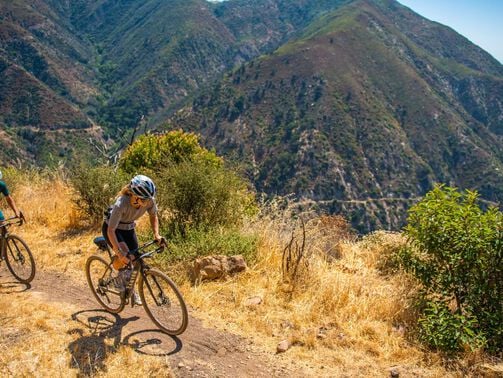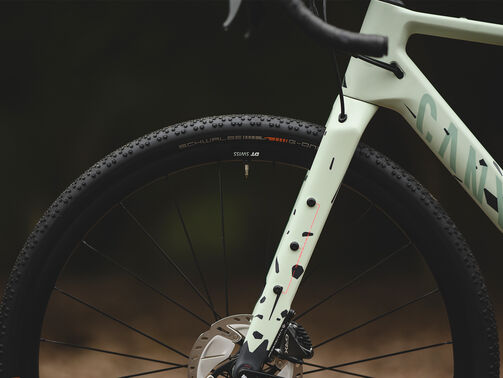What is Gravel Racing?
Gravel racing has gone from zero to hero in just a few years attracting pros and amateurs alike – but what makes it so exciting?


Contents
What is gravel racing?
Endless kilometres over ever-shifting terrain all without a car in sight; gravel racing brings together the long-distance endurance of road riding with the technical skill and sheer grit of marathon mountain biking. Thanks to better bikes, adventurous routes, mass starts and rare opportunities for amateurs to square off against pros, gravel grinding is only getting bigger.
The basics of gravel racing
Gravel racing does what it says on the tin. It is a bike race that primarily takes riders on gravel roads – but a gravel road can be a lot of different things. When racers sign up for a Gran Fondo, they can be pretty sure that most of the event will be on pavement. When a mountain biker signs up for an Enduro race, chances are they’ll be riding trails, but in a gravel race the surfaces are constantly changing.
Switching from pavement and chunky gravel to loose dirt and occasionally even singletrack, picking the right bike for a gravel race is not always an obvious choice. It becomes even more difficult when you consider that famous races like the DK and the Trans Iowa are both over 300 kilometres long.
The wide spectrum of gravel races is part of the appeal, and gravel means very different things in different regions. Some are long and flat, other feature steep punch climbs and technical MTB-ish sections. Some races are close in dynamic to road racers — but instead of a single peloton, you’ll find many medium sizes groups.
On the other end of the spectrum, events like the Silk Road Mountain Race, Kyrgyzstan, offer rugged, expansive terrain where the challenging course often leaves riders traversing vast stretches alone, with few other racers in sight.
Why we love gravel racing
The thrill of cycling with the freedom of exploring nature? Sounds good to us. Gravel cycling is a unique sport that offers a refreshing escape from busy roads, replacing traffic with scenic, peaceful routes.
Here are a few of the things that make gravel racing so appealing:
Anyone who spends a lot of time out training on roads could use a break from traffic. To properly prepare for a gravel race, riders need to spend a lot of time riding off the beaten path. Getting out in the woods on a quiet forest road is a welcome relief after kilometres on tarmac with gas guzzlers whizzing by.
From flat tyres to broken derailleurs, a tough gravel course can cause serious mechanical issues. With no external support, riders have to keep their bikes up and running which often requires breaking out the tools for some mid-race maintenance, all adding to the challenge.
Gravel races can be a logistical challenge to complete successfully and with that extra effort comes a special kind of reward. Not to mention that some gravel races give more experienced off-road amateurs the opportunity to go toe-to-toe with and even beat WorldTour road pros.
Racing over 300 kilometres on rough and bumpy terrain requires a thoughtful setup and a special kind of bicycle. Finding your favourite tyre, the right saddle and the best handlebar can make massive differences over a gravel race, making picking the right gear particularly important.
Tracing the roots of gravel racing
Gravel racing has roots in early cycling when roads were often unpaved, and riders had to navigate rough terrain. Over time, as paved roads became the norm for racing, gravel racing emerged as a modern revival of these early cycling challenges.
Gravel racing grew in popularity in the 2000s, particularly in the U.S., where events like the Dirty Kanza (now Unbound Gravel) set the stage for its rise as a unique discipline. Its popularity soared as cyclists sought out the adventurous challenge of mixed terrains and self-reliance on long courses, giving rise to a global movement.
Today’s gravel races are held across various countries, with routes often highlighting scenic and remote landscapes, from wide-open plains to dense forests, making each race unique and testing endurance and skill on unpredictable surfaces.
Some well-known gravel races include:
- Unbound Gravel, USA: Often considered the premier gravel race, Unbound Gravel covers gruelling distances of up to 560 km (350 miles) through the rugged Flint Hills of Kansas.
- The Rift, Iceland: This 200 km (124 miles) race traverses volcanic landscapes, offering riders stunning, otherworldly scenery along with technical challenges.
- Gravel Epic Marrakesh: This race takes participants through Morocco’s breathtaking High Atlas Mountains, mixing challenging climbs up to 4000m with vast desert landscapes.

Tips for your first gravel race
Gravel races typically last from four to 12 hours, with some extending to 24 hours for ultra-endurance events. Nutrition, hydration and pacing strategies are critical, as is the ability to handle bike maintenance mid-race due to mechanical issues like flat tyres.
Here are some top tips from Canyon athletes:
Stick to your own rhythm early on, even if others sprint ahead. Within a few miles, the pack will thin, and you’ll naturally find riders matching your pace. Stay in a paceline to conserve energy and improve efficiency, and use proper etiquette by calling out obstacles, keeping a safe distance, and sharing the workload at the front.
Carrying essential bike maintenance tools like a multi-tool, tyre levers, spare tubes, a mini pump or CO2 inflator and a quick link for your chain. These will help you handle common issues like flats or chain breaks during the race.
Long bike races like Unbound necessitate eating early and eating often so that you have enough energy to keep pushing for really long distances. Don't wait until you're hungry to start eating or drinking—it’s all about taking in enough calories not to bonk.
Get comfortable eating and reaching for bottles while rolling on rough terrain. If you aren't confident or think it will make you drink less, use a hydration pack.
It can be tempting to skip aid stations if you’re feeling good, but 10 miles down the road, you might regret skipping the cookies and other sweet treats. Keep your own snacks accessible, too, you don’t want to have to get off your bike, hands off bars, etc., to reach your fruit snacks.
In an endurance race, the key is to keep moving forward. Riders who pass you early may face setbacks like mechanical issues or fatigue later on, and you can regain ground by minimising your idle time. Staying consistent and steady throughout the race will give you a strong advantage in the long run.
The race course terrain influences your setup. In technical or mixed terrain, a stiff and aggressive setup can be a disadvantage, and 2x drivetrains are generally more versatile than 1x unless your course is predominantly uphill.
700c wheels are generally good for racing, and tyre size and clearance should match the terrain. If you plan to ride and race in diverse conditions, a versatile bike like the Canyon Grizl is ideal for tackling all types of off-road adventures.
If you're not shooting for a podium finish, take time to enjoy the experience and take pictures along the way. Many riders wish they had taken more photos during the race to remember the journey.
Who are the best canyon gravel athletes?
Canyon's gravel athletes push the limits of endurance and adventure, making waves in the cycling world.
Katarzyna (Kasia) is a Polish professional cyclist excelling in both road and gravel disciplines; Niewiadoma is known for her versatility and strength across various terrains. In 2023, she won the UCI Gravel World Championships, marking a significant achievement in her career as her first gravel race, dominating the 140 km course in Italy.
Kasia rides for the CANYON//SRAM Racing team, and her bike setup, particularly the Canyon Grail, played a key role in her success during the Gravel Worlds.
A former WorldTour rider, Peter Stetina transitioned to gravel racing in 2019 and quickly became a dominant force in the sport. Known for his endurance and technical prowess on mixed terrain, Stetina has excelled in top events like the Belgian Waffle Ride and Unbound Gravel, consistently finishing on the podium.
Riding for Canyon, Stetina leverages the performance of gravel bikes, including the Canyon Grail and Grizl, to navigate the challenging courses and maintain his position as one of the premier gravel racers in the world.
Carolin Schiff is a top gravel athlete and a rider for Canyon CLLCTV. After transitioning from road racing, she quickly rose to prominence in the gravel scene. Her impressive solo victory at the 2023 Unbound Gravel 200, one of the most prestigious gravel races, marked a turning point in her career.
Schiff's consistent performances across major gravel events, including wins at the Traka 200 and the Hegau Gravel Race, have solidified her reputation as a force in the sport.

Gravel vs road racing, what’s the difference?
Gravel and road racing may both be on two wheels, but they differ vastly in terms of intensity, tactics, and the demands they place on riders.
Road races are generally more consistent in length and intensity, while gravel races can vary significantly, making them harder to predict and prepare for.
Gravel events feature diverse terrain, from smooth gravel to technical trails, with course difficulty and distance varying greatly. In contrast, road races are typically shorter and more predictable in terms of course and intensity.
Gravel races attract both pros and strong amateurs, creating a highly competitive environment where placing highly often requires elite endurance and bike-handling skills.
Gravel racing emphasises endurance and Functional Threshold Power (FTP), with riders pushing hard until the field narrows.
Larger athletes can sometimes benefit from varied terrain, while the high rolling resistance of gravel means there's less chance to rest in the draft, making FTP crucial.
In road races, especially lower categories, tactics often come into play, with races ending in bunch or reduced sprints, emphasising short bursts of power.
In gravel, while group dynamics exist, the higher rolling resistance means less drafting, and the smaller groups make technical ability and endurance more important.
Gravel racing has a more relaxed atmosphere for those not chasing the podium. Even after getting dropped, smaller groups continue the race, whereas being dropped in a road race often marks the end for many riders.
Gravel riders often face fatigue due to constant impacts at high speeds, especially without suspension stems or forks.
Gravel racing tends to be more individualistic, with less frequent peloton riding. You can still collaborate with other riders, but groups are smaller, and technical skills become more critical depending on the terrain.
Gravel racing combines elements of road cycling and mountain biking, offering endurance challenges over varying terrain like gravel, dirt, and even singletrack. These races attract both amateurs and professionals due to their unique mix of technical skill, endurance and adventure.
Ready to gravel race? Find your ideal gravel bike from Canyon’s lineup.
Did this article help?
Thank you for your feedback




